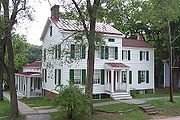
The Stephens-Black House
Encyclopedia

Historic Richmond Town
Historic Richmond Town is a living history village and museum complex in the neighborhood of Richmond, Staten Island, in New York City. It is located near the geographical center of the island, at the junction of Richmond Road and Arthur Kill Road....
on Staten Island
Staten Island
Staten Island is a borough of New York City, New York, United States, located in the southwest part of the city. Staten Island is separated from New Jersey by the Arthur Kill and the Kill Van Kull, and from the rest of New York by New York Bay...
, New York City
New York City
New York is the most populous city in the United States and the center of the New York Metropolitan Area, one of the most populous metropolitan areas in the world. New York exerts a significant impact upon global commerce, finance, media, art, fashion, research, technology, education, and...
.
The deed to the Stephens-Black House suggests that its construction began shortly after 2 February 1837. It is located on a 25 by 100 foot plot at the corners of Center Street and Court Place. It was built in a modified Greek Revival style which is most apparent in the eyebrow windows located on the third level of the home. The main floor of the original structure included a side hall entry with two adjoining formal parlors. The second floor originally housed three large bedrooms. The third parlor was added on to the western side of the structure sometime after 1840. Two more bedrooms were the added above the third parlor. The basement of the structure houses both a functioning 1830's kitchen and what was once the home's dining room. The adjoining General Store
General store
A general store, general merchandise store, or village shop is a rural or small town store that carries a general line of merchandise. It carries a broad selection of merchandise, sometimes in a small space, where people from the town and surrounding rural areas come to purchase all their general...
was built as a series of additions between 1840 and 1870.
Stephen Dover Stephens, born in 1808, was the original owner. He owned the home and operated the store between 1837 and 1870. He was married to Elizabeth Johnson in 1829 at Saint Andrew's Church, which is also located in Richmondtown. Their five children Stephen Dover Jr., William James, Lucretia, Mary Elizabeth Jr, and Charlotte Ann were all baptized at that same church.
In 1870 both the home and the connected store were sold to Mary and Joseph Black. The Stephens family then moved up the road to the Stephens Prior House. Mr and Mrs. Stephens both resided there until their deaths in 1883. The Black family raised eleven children in the home and their family operated the store until 1926. In 1926 the remaining members of the Black family sold the store to Willet and Bertha Conner whom operated a post office
Post office
A post office is a facility forming part of a postal system for the posting, receipt, sorting, handling, transmission or delivery of mail.Post offices offer mail-related services such as post office boxes, postage and packaging supplies...
in the store until the time of the Second World War
World War II
World War II, or the Second World War , was a global conflict lasting from 1939 to 1945, involving most of the world's nations—including all of the great powers—eventually forming two opposing military alliances: the Allies and the Axis...
. After which the house was separated into two apartments and rented until the mid-1960s when it became property of Historic Richmond Town
Historic Richmond Town
Historic Richmond Town is a living history village and museum complex in the neighborhood of Richmond, Staten Island, in New York City. It is located near the geographical center of the island, at the junction of Richmond Road and Arthur Kill Road....
.
Sources
- http://www.neighborhoodpreservationcenter.org/ Neighborhood Preservation Center, New York, NYNew York CityNew York is the most populous city in the United States and the center of the New York Metropolitan Area, one of the most populous metropolitan areas in the world. New York exerts a significant impact upon global commerce, finance, media, art, fashion, research, technology, education, and...

